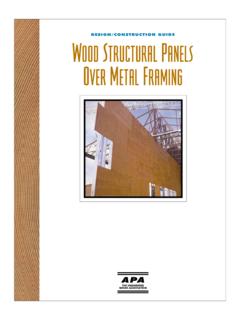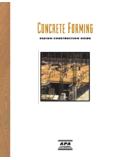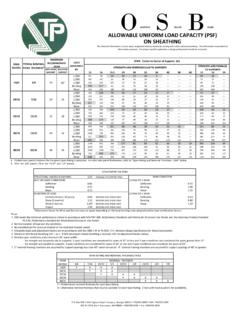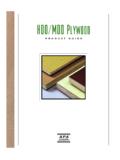Transcription of Load-Span Tables for PS-1 Plywood - Socomi
1 TECHNICALNOTELoad- span Tablesfor PS-1 PlywoodAPAThe Engineered Wood AssociationNumber Z802 KMarch 1998 Load-Span Tables for specific woodstructural panel applications areincluded in several APA loads for sheathing andflooring applications in these publica-tions directly reflect minimum perfor-mance criteria given in VoluntaryProduct Standard PS 1-95, VoluntaryProduct Standard PS 2-92 and inAPA PRP-108 Performance Standardsand Policies for structural -Use qualify for a given span Rating underthese standards, a panel must meet allof the criteria for that rating. As a result,mechanical properties that are charac-teristic of APA wood structural panelsare actually greater than the minimumnecessary to pass one it is sometimes necessary tohave engineering design informationfor PS-1 Plywood for conditions notspecifically covered in the other APAliterature, APA publishes separatedesign section properties and workingstresses for the various grades andthicknesses.
2 These values are listed inAPA s Plywood Design Specification(PDS), and are recognized by themodel building codes. The uniformloads in the following Tables werecalculated using these properties andstresses, or resulting section capacitiesfor the various span Ratings. Theseloads are recommended when engineering principles are used fordesign. It is important to rememberthat structural engineering principlesalone do not necessarily take intoaccount other factors, such as mois-ture and thermal conditions, whichmay impact following Load-Span Tables apply tosanded, touch-sanded, and unsandedplywood manufactured in accordancewith Voluntary Product StandardPS 1-95, with face grain parallel to sup-ports, and face grain across supports. Foreach combination of span and thickness(or span Rating), loads are given fordeflections of L/360, L/240 and L/180,and maximum loads controlled by bend-ing and shear capacity.
3 Uniform loads forsome applications can be read directlyfrom the Tables . In other cases, the valuesgiven in the Tables should be adjusted forspecial conditions using the factors listedin the table of Adjustment Factors. table 1 applies to unsanded plywoodand is based on APA RATED SHEATH-ING (marked PS 1) grade. For touch-sanded grades such as C-D Plugged, C-C Plugged, UNDERLAYMENT andAPA RATED STURD-I-FLOOR (markedPS 1), see table 2. table 3 applies tosanded grades such as A-D and Tables also assume dry conditions,normal duration of load , and untreatedplywood with interior glue. For otherconditions, the loads should be appropri-ately adjusted using the factors given. Forinstance, roof loads based on bendingand shear stress may be increased 15%for short duration of snow load . See theexamples for proper application of adjust-ment factors.
4 Further details on plywoodstresses and adjustments are given in thePLYWOOD DESIGN face grain across supports, and spansof 32" and less, three spans are assumed,and two spans for spans greater than 32".For face grain parallel to supports, tablesare based on three spans for spans of 16"and less, and two spans for 24". Thetables do not apply directly to plywoodhaving a single span . For one- span condi-tions, use the span adjustment of support width have been considered when determining the loadsbased on shear and deflection. Supportsare assumed to be 2x nominal membersfor spans less than 48", and 4x membersfor 48" and greater spans. Support-widthfactors are those established by APAL aboratory Report is important to note that some plywoodapplications are not controlled by uni-form loads. Residential floors are a goodexample.
5 They are commonly designedfor 40 psf live load . The allowable uni-form floor load on Plywood applied atmaximum span according to APA recom-mendations is greatly in excess of thetypical design loads. This excess does notmean that floor spans for Plywood can beincreased, but only that there is consider-able reserve strength and stiffness foruniform loads. Actually, the recommenda-tions for Plywood floors are based onperformance under concentrated loads,how the floor feels to passing foottraffic, and other subjective factors whichrelate to public acceptance. Always checkthe maximum floor and roof spans forplywood before making a final plywoodselection for these , 4/13/00 9:56 AM Page 12 1998 APA THE ENGINEERED WOOD ASSOCIATION ALL RIGHTS RESERVED. ANY COPYING, MODIFICATION, DISTRIBUTION OR OTHER USE OF THIS PUBLICATION OTHER THAN AS EXPRESSLY AUTHORIZED BY APA IS PROHIBITED BY THE COPYRIGHT 1 UNIFORM LOADS (PSF) ON UNSANDED ( span RATED) Plywood PANELS MULTI- span , NORMAL DURATION OF load , DRY CONDITIONSFace Grain Parallel to SupportsSpanLoadFace Grain Across SupportsSpan, Center-to-CenterRatingGovernedSpan, Center-to-Center of Supports (inches)of Supports (inches) "L/2402516135788550628023420615410553159 3773309(GroupsL/18033551809 118167537331227420514071212410314121 & 2)Bending1047589409262168147937552347684 32154 Shear91165954042533531326623820616272552 5325 table OF ADJUSTMENT FACTORSD uration of load (Applies to Bending and Shear Only).
6 Permanent load (over 10 years) months, as for or earthquake (check local code) or Stresses for Plywood Grades:Exposure 1 or exterior (shear) structural (shear)Groups 2 and 3 for sanded or touch sanded ( Tables 2 & 3) (bending) (deflection)Group 4 for sanded or touch sanded ( Tables 2 & 3) (bending) (deflection)Preservative Treatment:No adjustment requiredFire-Retardant Treatments:Check with company providing the treatment and redrying service foradjustment or Damp Locations (Moisture Content 16% or more):Exterior and Exposure 1 (Interior with exterior glue) Adjustments:2- span to to , 4/13/00 9:56 AM Page 23 table 2 UNIFORM LOADS (PSF) ON TOUCH-SANDED (GROUP 1 OR span RATED) Plywood PANELS MULTI- span , NORMAL DURATION OF load , DRY CONDITIONST hicknessFace Grain Parallel to Supports(inches)LoadFace Grain Across SupportsSpan, Center-to-Centeror SpanGovernedSpan, Center-to-Center of Supports (inches)of Supports (inches)
7 OcBending345194135865549312517844717 Shear38928123118114313411410288251182113 L/3606072751638543363123157109461719/32, L/24091141324512765544734231116469255/8 orL/180121455132616987716346301521992332 0 ocBending4012251571006456362920131861053 7 Shear49035429022818016914312811187295214 132L/36091543626514173615339261319786322 3/32,L/240137365539821111091805939192951 29473/4 orL/180183187353128214712110778522639317 16324 ocBending5353012091348675483927172871615 7 Shear60243635728122220717615813610733324 11491-1/8L/36018841016663379209175154115 784012025832332-4-1L/2402826152499556931 4263231172118601803875349(Groups 1,L/18037682032 132675841935130823015780240511674662 or 3)Bending1343755524336215189119976743102 2575204or 48 ocShear102974561048037935430126923318478 1566350TN, 4/13/00 9:56 AM Page 34 table 3 UNIFORM LOADS (PSF) ON GROUP 1 SANDED Plywood PANELSMULTI- span , NORMAL DURATION OF load , DRY CONDITIONSFace Grain Parallel to SupportsThicknessLoadFace Grain Across SupportsSpan, Center-to-Center(inches)GovernedSpan, Center-to-Center of Supports (inches)of Supports (inches) 11496573633042671991366923991164465 Bending112863444028218015910081563610235 75205 Shear90465453642233331126423720516177155 8345TN, 4/13/00 9:56 AM Page 45 Examples Showing Use of Plywood Load-Span TablesExample 1: Find the allowable uniform floor load for APA RATED SHEATHING 32/16 Exposure 1.
8 Assume 10 psf dead load , and face grain across supports 16" Unlessstated otherwise, assume floor deflection criteria to be L/360 under live load only andL/240 under total table 1, for Unsanded Panels with Face Grain Across Supports:Allowable total load for floors is the least of loads for L/240, bending and total load is 165 load is the lesser of the load for L/360 and total load as determined above, minusdead = 181 psfTotal load dead load = 165 10 = 155 psfAllowable live load is 155 : Do not increase span even though the allowable uniform live load greatly exceeds the 40 psf design live load normally used for floor design. Recommendedmaximum span reflects performance under concentrated and impact loads in addition to uniform 2: Find allowable snow loads onAPA RATED SHEATHING 48/24 Exposure1 if face grain is across supports spaced 32" In question are several panels in the 1- span condition.
9 Deflection criteria areL/240 under live load only and L/180under total load . Assuming a 2-monthduration of load for snow, allowable loadsfor bending and shear may be increased15%. Assume 10 psf dead load supportedby the table 1, for Unsanded Panels with Face Grain Across Supports:Allowable total load is the least of loads for L/180, bending and shear. Allowable total load is 75 load is the lesser of total load minus dead load (75 10 = 65 psf), and load at L/240 (57 psf).In this case, live load is controlled by deflection of L/240: Allowable live load = 57 psf, or 55 psf (rounded to nearest 5 psf).Example 3: Find allowable soil pressure on 23/32" APA C-C Plugged Group 1 EXT if supports are 16" Face grain isacross supports. Deflection need not beconsidered. Assume soil pressure is permanent table 2, for Group 1 Touch-SandedPanels with Face Grain Across Supports:Allowable load = 190 Loadfor LoadBy(psf) Exposure 1 (psf)L/360181181L/240271271 = 285 LoadAdjustmentAdjustmentAdjustedGoverned Loadfor DurationAdjustmentforLoadBy(psf)of Loadfor SpanExposure 1(psf) DurationforforLoadBy(psf)of LoadMoistureExterior Glue(psf) , 4/13/00 9:56 AM Page 5 APAThe Engineered Wood AssociationWe have field representatives in most major cities and in Canada who canhelp answer questions involving APAtrademarked products.
10 For additionalassistance in specifying APA engineeredwood products, get in touch with yournearest APA regional office. Call or write:WESTERN REGION7011 So. 19th St. Box 11700 Tacoma, Washington 98411-0700(253) 565-6600 Fax: (253) 565-7265 EASTERN REGION2130 Barrett Park Drive, Suite 102 Kennesaw, Georgia 30144-3681(770) 427-9371 Fax: (770) HEADQUARTERS AND INTERNATIONAL MARKETING DIVISION7011 So. 19th St. Box 11700 Tacoma, Washington 98411-0700(253) 565-6600 Fax: (253) 565-7265 PRODUCT SUPPORT HELP DESK(253) 620-7400E-mail Address: Antwerp, Belgium; Bournemouth,United Kingdom; Hamburg, Germany;Mexico City, Mexico; Tokyo, Japan.) ForCaribbean/Latin America, contactheadquarters in product use recommendations in thispublication are based on APA TheEngineered Wood Association s continuingprograms of laboratory testing, productresearch, and comprehensive field experi-ence.







